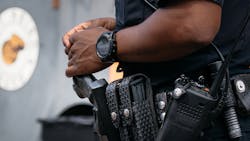Focus on Transition Training With De-Escalation
“De-escalation” has become quite the buzzword in policing circles over the past decade. To the outside world of media, courts, and politicians, one would think it’s a brand new concept. Yet to the law enforcement community, de-escalation is as old as the profession itself.
I’ve always told my students and officers that your greatest gift is also your greatest weapon, your mind and your mouth. Trying to use calm and tact is all part of the job. Being able to effectively get a person in custody without any use of hands-on tactic or weapon has always been a preferred objective. This has become especially true when law enforcement is dealing with people in crisis, of special needs, drug or alcohol influenced, or special populations like the young and elderly.
Yet there are times when all the talking in the world will not get the person in custody and a force technique must be used. And there are also those times when due to the person’s imminent threat against another person, themselves, or the officer, there is just no time to try to talk. Sometimes those techniques require a higher degree of force like batons, strikes, or even a firearm. Force isn’t pretty, especially to the layperson who thinks every police encounter should be handled through verbal de-escalation.
Police trainers and policy-makers could be doing themselves a disservice by overusing the term “de-escalation” without training on it. For those agencies who were bullied or forced to mandate a “de-escalation-at-all-costs” mentality by anti-police policy-makers, they are only adding fuel to the fire of those who think every force event is avoidable. They are also setting up their officers to fail and for their agencies to be sued due to the language they imposed on themselves that gives an unrealistic expectation for all force encounters.
This is NOT a column against de-escalation, as I said, an officer’s best tactic is their mind and mouth and using the combination of the two to try and avoid force when feasible should always be the street objective. While de-escalation deserves it’s place in every academy, training room, and policy, agencies and trainers should equally focus on an officer’s ability to “transition” their force based on their threat assessment. In other words, we cannot be expecting each force encounter to be minimized, sometimes force needs to be increased in order to save a life. Agencies should be focused on force transition techniques to do this.
Force transition means teaching officers to always keep their options open and be ready to quickly transition between those options. This should include training and guidance to go from one tactic to another as efficiently as possible while using verbalization techniques and identifying the reasons why. How many times have you’ve seen an officer’s first go-to tactic being a Taser and then draw the proverbial “line in the sand” with the subject? As the person’s threat level changes, I would be willing to bet most officers are still stuck with that Taser in their hand. Worse yet, is when an officer brandishes a firearm and then sticks with it as their method to control a situation when deadly force may no longer be justified.
Trainers and agencies should focus on training transition techniques. Starting with a strong reminder of using ongoing threat assessment as a guide for all actions, and then moving onto isolation drills of presenting, securing, and transitioning to another tactic. Start with empty hand readiness, and go to a firearm, then back to empty-hand. Start with a baton and escalate to a firearm, and end up with empty hand. Start with OC and transition to firearm, and then end up with a Taser. These isolation drills create a physiological imprint to remind the officer of their force options and transition capabilities. After the isolation drills, scenario-based training that requires 2 to 3 transitions before a final force outcome is recommended. And finally, have the officer articulate their force through a post-training report in which the officer must describe the subject’s actions as they saw it and what the officer did in response.
Policies should also highlight transition training when discussing de-escalation, for one simple reason, police are human. The overuse of the word, “de-escalation” in today’s society is forcing many officers to second-guess their force options. Officers may not be willing to engage in a higher-level of force like impact weapons or strikes for fear of being sued or criminally charged, when that level of force could have prevented the situation from spiraling out of control and leading to a deadly force encounter. On the flip side, an officer might initially draw their firearm based on the threat, and then try to use verbal de-escalation alone, completely forgetting about all of the force options in between.
De-escalation is vital in police training and policy, but you cannot tell officers to do it without providing them the physical tools and techniques needed to do it effectively. Officers need to be guided to react to force through ongoing assessment, and sometimes that means going higher on the use of force scale to avoid using deadly force. If all the officer hears is de-escalation, that could send mixed messages and end up resulting in an improper tactic that doesn’t fit the suspect’s behavior. If all they train on is de-escalate, you are stripping options away from the officers which could result in their harm, or unnecessary harm to the subject.
Not all force encounters can be de-escalated, the pendulum swings both ways, adding transition training to your agency should result in less headaches, headlines, and harm.
About the Author
Brian Landers is a former law enforcement officer and current professor of criminal justice. He also serves as an expert consultant and witness for police use of force incidents throughout the United States. He can be reached at [email protected]
About the Author
Brian Landers
Brian Landers is a former law enforcement officer and current professor of criminal justice. He also serves as an expert consultant and witness for police use of force incidents throughout the United States. He can be reached at [email protected]

